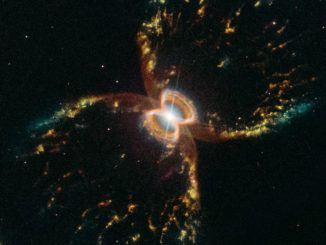The European Southern Observatory’s 8.2-metre Very Large Telescope captured the most detailed view yet of NGC 2899, a colourful twin-lobed planetary nebular that resembles a vast butterfly surrounded by glowing clouds of high-temperature gas. Reaching temperatures of some 10,000 degrees, the gas is heated by torrents of radiation from the nebula’s parent star, with hot hydrogen creating a reddish halo surrounding the blue of oxygen gas. Located in the southern constellation Vela, the nebula features two central stars. One, near the end of its life, blew off its outer layers but the other star interferes with the outward flow of gas, creating the unusual two-lobed shape. Only 10 percent to 20 percent of planetary nebulae feature such bipolar shapes. This spectacular image was captured by one of the VLT telescopes using the FORS instrument.




